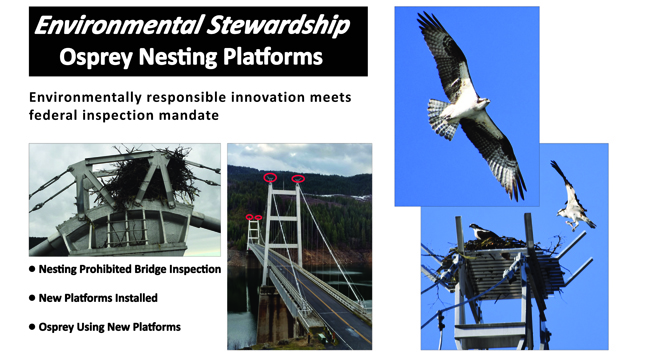

New platforms provide osprey housing, enable bridge safety inspections
Many innovations start with meeting a need. This one arose from an environmental and federal safety necessity.
The Federal Highway Administration (FHWA) requires an inspection of the 1,500-foot-long Dent Bridge every two years, but the Idaho Transportation Department (ITD) could not inspect the overhead cable saddles because of nesting osprey, which are federally protected migratory birds.
The 45-year-old bridge spans the Dworshak Reservoir on the North Fork of the Clearwater River, north of Orofino.
“Inspectors needed to check the bridge, but could not inspect the top of the towers because of the nesting osprey,” said ITD Bridge Asset Management Engineer Dan Gorley. “Efforts in 2014 to remove the nests when they were unoccupied, in order to clear the area for inspection, only resulted in the birds returning to rebuild the nests in the same spot in 2015. Three huge, new nests appeared – each weighing at least 600 lbs.”
ITD needed to come up with an environmentally responsible plan to accommodate both the birds and the inspections.
Four new aluminum platforms were manufactured by ITD’s District 2 in early January and installed in late January. The new platforms were installed three feet above the current nesting areas, at the bridge’s crown, about 125 feet above the bridge’s driving surface. Each platform is approximately five feet wide by five feet long, and designed to hold up to 1,000 pounds.
By early April, four adult osprey could be seen occupying two separate nests with their families.
Here is the link to a video detailing the story of the platforms: https://youtu.be/AJxW7wEVW5E
ITD’s osprey-nest platform is one of the nation’s first. Many raptor-nest platforms have been built on utility facilities, but ITD’s innovation is a rare example of a raptor platform constructed on a bridge. This innovation may offer a solution to other local and regional transportation agencies grappling with the same problem, as well as other departments of transportation nationwide.
This project may also allow biologists an opportunity to learn more about the osprey regarding territorial tolerance with other osprey and new nesting opportunities.
The overall budget for the platforms was approximately $10,000, including materials, manufacturing and installation. A bridge inspection costs about $22,600. The platforms more than made up for the cost of an unsuccessful inspection.
Biologists may also be able to use some of the lessons learned from the osprey platforms to inform decisions in the future. For instance, the birds may use multiple platforms on the same bridge, if the platforms are far enough apart and there in a consistent food supply nearby. Providing these nesting opportunities for the osprey may also allow biologists more opportunity to observe the bird’s behavior.
The platform innovation is a powerful example of the kind of collaborative win that can result from the partnership of several agencies. In this case, three ITD sections (Environmental, Bridge and District 2, who manufactured the new platforms) coordinated with the U.S. Fish & Wildlife Service (who provided biological expertise) and Clearwater County (who helped fund and install the new platforms).
Published 04-29-16